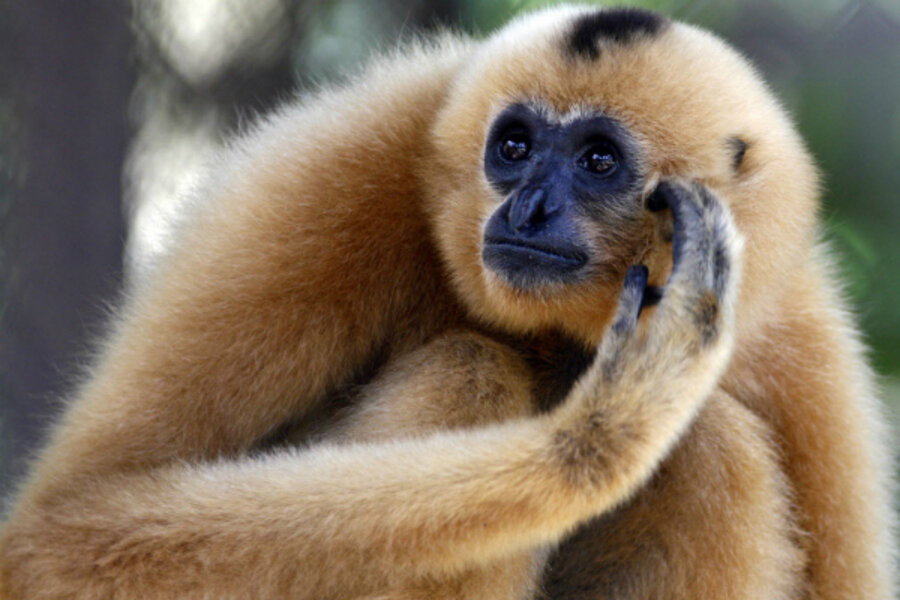Why are some mammals monogamous? Two definitive studies not so definitive.
Loading...
Wolves do it, beavers do it, even some termites pair off as monogamous couples to procreate.
Now, two teams working independently have offered competing explanations for why some mammal species, including those among primates, stick with one mate.
One team analyzed patterns in the evolution of reproductive behavior in more than 2,500 mammal species, including primates, and found that monogamy most likely arose as a male response to breeding females' penchant for guarding their turf.
Females needed access to relatively scarce, high-qualify food, to help ensure their reproductive success, the team holds. That scarcity led them to defend their territory from other females. Because females were distributed over a wide area, it would have been too difficult for a male to gather and defend a harem. So, he would settle down as the sole partner for a female, who would share her territory with him for more than a year.
"In mammals, social monogamy is a consequence of resource defense," said Dieter Lukas, a zoologist at Cambridge University in Britain, during a press briefing Monday. "Female behavior is influenced by the distribution of food. And male behavior is influenced by the distribution of females."
That holds true for primates, as well as other mammals, he said.
Dr. Lukas conducted the study with Cambridge University colleague and evolutionary biologist Tim Clutton-Brock. A formal description of the work and results are set for publication Friday in the journal Science.
A second team, led by Kit Opie, an anthropologist from University College London, acknowledges a role for territorial-defense among breeding females in the evolution of social monogamy in its study group – 230 species of primates.
But, the researchers argue, that piece of the puzzle fell into place later. The main driver behind social monogamy, they say, was a need to have a male on hand to reduce the risk of infanticide by another male trying to mate with a female while she is still nursing an earlier offspring.
"This brings to a close the long-running debate about the origin of monogamy in primates," said Dr. Opie in a prepared statement. The study is set for publication Tuesday in the Proceedings of the National Academy of Sciences.
If nothing else, the pair of studies highlight the keen interest in unraveling the mystery of monogamy among mammals. Researchers note that social monogamy prevails among 90 percent of bird species. But among 2,545 species covered in the Lukas team's study, only 9 percent of the species exhibited a single-partner preference among breeding females. Other estimates put the figure as low as 3 percent for all mammal species. Among primates, breeding females in 29 percent of all species settle for a single partner.
Over the past decade, several studies have offered explanations for monogamous behavior. Some suggest monogamy arose as a kind of burden-sharing between male and female in raising young, which increased the reproductive success of the species, researchers say. Others have offered the infanticide and resource-defense scenarios.
Both teams based their analyses on existing field research on animal behavior as well as the relationships among species on the evolutionary tree established by genetic analysis.
This "phylogenetic" approach is a powerful tool, the researchers say. It helps establish evolutionary relationships among species based on analysis of DNA, rather than relying largely on an animal's appearance or anatomy to tease out evolutionary relationships. Phylogenetics also can yield improved estimates of when related species split from a common ancestor.
If two closely-related species made that split fairly recently, and in both species the breeding females are monogamous, "we would assume that their common ancestor also was socially monogamous," Dr. Lukas said.
Previous studies that focused on the search for helpful males among 229 monogamous mammal species that found that in about 60 percent of these species, males pitched in to carry offspring and search for food for them.
But "with prenatal care, we observe that the change to male care occurs ... only after social monogamy already has been established," Lukas said.
In analyzing more than 2,500 mammal species, the team uncovered 61 independent transitions from solitary ancestors to socially monogamous descendants. For all but one, the emergence of social monogamy stemmed from breeding females living in their own territories, while males roamed among the territories.
The team found the highest prevalence of monogamy among carnivores and primates, compared with mammals whose diet was dominated by plants. And the scientists team found no evidence for infanticide by males as a driver toward monogamy among any of the species it examined, including primates.
Opie's group, on the other hand, found that infanticide predated the appearance of monogamy, while turf defense and the helping hand of a male in raising offspring came after the shift to monogamy.
Both studies relegate the notion of a helpmate for females as they rear their young to an effect of monogamy, not a trigger.
Dr. Clutton-Brock offered possible explanations for the seemingly at-odds conclusions of the two studies.
For instance, the sample sizes in the studies are vastly different, as are the number of independent transitions to monogamy each team identified – 61 in the Cambridge study and only five or six in the other work. Or the two teams could be using different means of classifying species phylogenetically.
Whatever the reasons, Clutton-Brock says he's keenly interested in working with Opie's team to understand the reasons for the split decision on infanticide vs. territorialism as the trigger for social monogamy in mammals.
"Until a few days ago, we had no idea that this [other] paper existed," he said. "Had we known that there was this difference and that there were two teams operating in this way we would have got together before and try to sort out our differences. What we will do now is to do just that."







